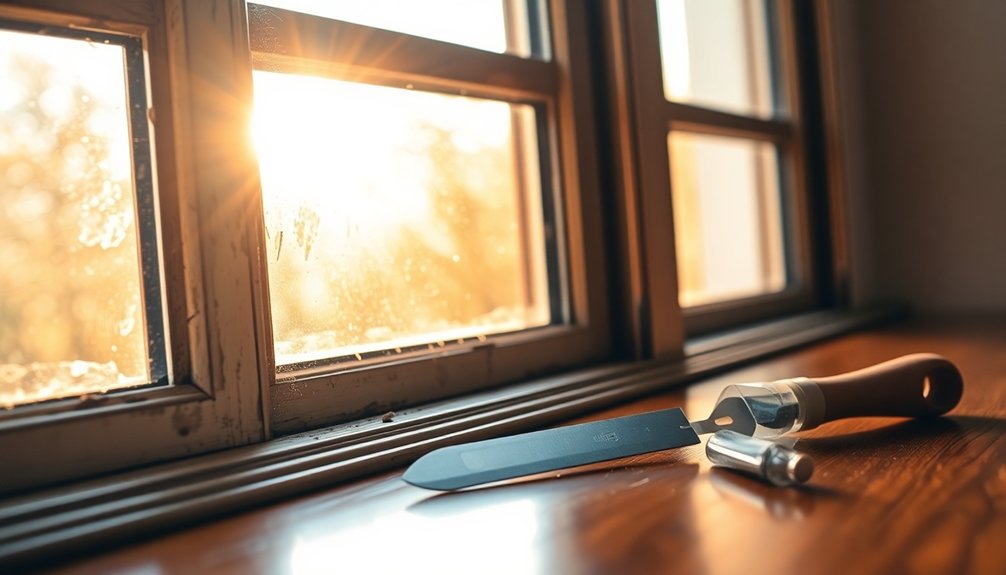Replacing window seals is essential for effective home maintenance and energy efficiency. You can spot seal damage by looking for foggy glass, drafts, or increasing energy bills. Over time, seals can break due to age, temperature fluctuations, or neglect. Repair methods vary; while DIY options can save money, professionals guarantee compliance and quality. Maintenance like regular inspections can extend seal life. Explore further to uncover detailed steps for replacement and tips to maintain your window seals.
What Are Window Seals?
When you think about window seals, consider them as the vital barrier that keeps your home comfortable and energy-efficient. A broken window seal allows air leaks, compromising the performance of insulated glass units, such as double-pane windows.
These seals typically contain gases like argon or krypton, which enhance energy efficiency by maintaining temperature control. When seals fail, moisture gets trapped between the panes, leading to foggy windows and distorted reflections. This not only reduces visibility but can also increase your utility bills due to excessive heating and cooling requirements.
Regular seal repairs are important in preventing these issues, ensuring your windows perform at their best and contribute to a more comfortable living environment while keeping costs down. Additionally, monitoring financial goals related to home maintenance can help you budget effectively for necessary repairs.
How Can You Tell If a Seal Has Been Damaged?
You can identify a damaged window seal through several clear signs.
Look for foggy glass, distorted reflections, or visible gaps, which indicate moisture buildup and air leaks.
Additionally, if you notice increased energy bills or difficulty opening and closing your windows, it’s time to assess the seals for potential failure. A thorough check can also help you discover cost-effective options for replacing damaged seals that can improve your home’s energy efficiency.
Visual Indicators of Damage
Identifying the visual indicators of damaged window seals is essential for maintaining energy efficiency and comfort in your home.
Look for fog inside the panes; this moisture buildup often signals seal failure. You might also notice drafts around the window frames, indicating that the seal has shifted or deteriorated, allowing outside air to enter.
If you’re facing increased energy bills, it could be due to a broken seal affecting insulation. Additionally, distorted reflections in the glass suggest gas escape from double or triple-pane windows, which typically results from seal damage.
Finally, if you experience difficulty in opening or closing your windows, it may point to issues with the seals or frames not functioning properly.
Energy Efficiency Decrease
As window seals deteriorate, energy efficiency often takes a noticeable hit, making it essential to recognize the signs of seal failure.
One clear indicator is condensation or fogging between the glass panes, which signifies moisture buildup from a damaged seal.
You’ll also notice distorted reflections in the glass, suggesting air infiltration that disrupts your home’s energy efficiency.
If you feel drafts around the window frame, try the wet hand test to detect temperature changes indicating air leaks.
Additionally, keep an eye on your energy bills—higher energy bills, often by 10-25%, can signal that insulation effectiveness is compromised.
If you suspect seal damage, consider window seal repair or replacing window seals to restore efficiency.
Physical Opening Difficulties
Window seals not only impact energy efficiency but also affect the ease with which windows open and close.
If you notice windows sticking or needing excessive force, these could be signs of seal failure. Damaged seals can lead to warped frames, making operation difficult. Increased drafts or air leaks signal potential issues, while foggy panes often indicate moisture buildup from broken seals.
To address these problems, regularly inspect for damage and uneven gaps. If you find significant issues, it’s time to consult a window repair company to replace window seals.
A Professional Window Seal can greatly improve your home’s comfort and restore proper functionality, ensuring your windows meet ideal window ratings.
Don’t wait until the damage worsens; act now.
Why Window Seals Break
When the seals around your windows begin to fail, it’s often due to a combination of environmental stressors and neglect.
One major culprit is solar pumping; the gases inside the panes expand and contract, stressing the window seals over time. Additionally, age-related deterioration makes older seals more susceptible to breakdown.
If you neglect to clean and inspect windows regularly, dirt and moisture can accumulate, compromising the seals further.
Extreme temperature changes also play a significant role, weakening seals and causing cracks.
Finally, weather events like heavy rain can introduce water into the window sash, increasing the risk of seal damage.
Understanding these factors can help you prevent seal failure and maintain your windows effectively. Moreover, utilizing apps like expense management tools can aid in budgeting for necessary home repairs, ensuring that you are financially prepared for maintenance tasks.
Best Window Seal Repair Methods

When addressing window seal repairs, start by checking if your insulated glass unit (IGU) is still under warranty, as this can save you significant costs.
You’ll need to weigh the benefits of hiring a professional contractor against DIY options; while professionals guarantee quality and may offer warranties, DIY methods can be effective for minor issues but carry risks.
Regular inspections of your windows can help you catch problems early, guaranteeing timely repairs for peak energy efficiency. Additionally, establishing a routine for checking alerts regularly can help you stay on top of maintenance tasks and ensure timely repairs.
Warranty Check Importance
Understanding the importance of checking your warranty can save you both time and money, especially when dealing with window seal failures.
Warranty checks are essential for homeowners, as many window manufacturers offer coverage for seal repairs or replacements. Knowing the specifics of your warranty can reveal if your seal failure is eligible for a free repair, minimizing your costs considerably.
Keep in mind that warranty claims often have specific timeframes, typically ranging from 5 to 20 years. It’s vital to document any signs of seal failure promptly; timely reporting can expedite your claims process.
Additionally, understanding your warranty details will inform whether you should pursue professional repairs, as DIY attempts may void your warranty.
Professional vs. DIY Options
Choosing between professional repairs and DIY options for window seal issues can greatly impact both the quality of the repair and your long-term costs.
Professional window seal repair typically ranges from $70 to $245, ensuring high-quality results and warranties. They can accurately assess damage and recommend specialized repair methods, safeguarding your window manufacturer’s warranty.
On the other hand, DIY methods, like using silicone sealant for exterior cracks or window seal tape for sash-frame gaps, are budget-friendly but may lead to further damage if not executed correctly.
For complex windows or extensive damage, consulting a professional is advisable to prevent costly mistakes.
Ultimately, weigh the cost against the potential risks of DIY repairs before proceeding.
DIY vs. Professional Window Seal Repair
How do you decide between DIY and professional window seal repair? If you’re facing minor issues, a DIY approach might be cost-effective, typically ranging from $70 to $120.
However, improper execution can lead to further damage and possibly void your warranty. For extensive or complex damage, hiring a professional is often safer. Their services usually range from $50 to $250 per window and come with warranties, ensuring compliance with manufacturer requirements.
Professionals can accurately assess damage and recommend the best repair methods, which is essential for intricate window types. While the initial cost may be higher, professional repairs can enhance energy efficiency and ultimately save you money by preventing additional issues and potentially needing to replace the window. Additionally, utilizing budget apps can assist homeowners in tracking expenses related to home maintenance and repairs.
Assessing the Condition of Your Windows

To effectively assess the condition of your windows, start by inspecting them for signs of wear and tear, such as air leaks, cracks, and moisture buildup, which can all indicate seal failure.
Inspect your windows regularly for air leaks, cracks, and moisture buildup to identify potential seal failures early.
Pay close attention to the window frame and look for any installation stickers or tags to determine the age of your windows; older models are often more prone to seal issues.
Homes built before the 1970s usually have single-pane windows, which are less energy-efficient.
Conduct regular maintenance by inspecting windows at least once a year to catch early signs of seal deterioration.
If you notice major issues, like cracks or mold, consider a professional assessment to decide whether to replace window seals or undertake more extensive repairs. Additionally, keeping an eye on operational costs can help you budget for necessary home maintenance like window seal replacements.
Choosing and Preparing Your Seals
After evaluating the condition of your windows, the next step involves selecting and preparing the right seals.
It’s essential to choose the appropriate sealant based on your local climate conditions. Here are three steps to follow:
- Remove old weatherstripping: Use a putty knife or scraper. Soften stubborn residue with soap and water to guarantee a clean surface.
- Clean window surfaces: Thoroughly remove dirt and debris to guarantee proper adherence of the new sealant.
- Choose sealant wisely: Opt for silicone for water-exposed areas and acrylic latex for drier climates. Aim for a U-factor rating of 0.30 or lower to enhance energy efficiency. Utilizing expense tracking tools can also help you budget for home maintenance projects effectively.
Once you’ve done this, you’re ready to apply new sealant effectively.
Step-by-Step Guide to Replacing Window Seals

Replacing window seals is a straightforward process that can greatly improve your home’s energy efficiency and comfort.
Start by gathering necessary tools like a utility knife, caulk gun, and new sealant suitable for your climate. Carefully use the utility knife to remove the old sealant from around the window, ensuring you clean the window surface thoroughly for proper adhesion.
Gather your tools, including a utility knife and caulk gun, to remove old sealant and prepare for a fresh application.
Next, apply a steady bead of new sealant along the frame, starting from the top and moving downward. Use a putty knife to smooth the sealant for a neat finish. Allow it to dry as per the manufacturer’s instructions—typically about an hour.
Regularly check your seals for signs of wear; timely replacements can help you save on energy costs and prevent the need to repair your window. Additionally, consider conducting regular billing process reviews to ensure you’re managing home maintenance costs effectively.
Maintaining Your Window Seals for Longevity
Maintaining your window seals is essential for guaranteeing energy efficiency and prolonging the life of your windows. To effectively maintain your window seals, follow these steps:
- Regularly inspect your window seals for signs of wear, like drafts, fogging, or condensation. Identifying issues early helps prevent air leaks.
- Clean window seals with mild soap and water to remove dirt and debris that can compromise seal integrity over time.
- Lubricate moving parts, such as window cranks and hinges, with silicone-based lubricant to guarantee smooth operation and reduce strain on seals.
If you notice persistent issues, schedule a professional assessment. Additionally, consider using expense tracking apps to manage the costs associated with home maintenance efficiently.
Timely repairs can considerably extend the lifespan of your windows while maintaining effective sealing and ideal energy efficiency.
Conclusion
To sum up, replacing window seals is like giving your home a revitalizing boost. By understanding the signs of damage and choosing the right repair method, you can restore energy efficiency and comfort. Whether you tackle it yourself or call in the pros, addressing seal issues not only enhances your windows but also protects your investment. Regular maintenance will keep your seals in top shape, ensuring your home stays cozy and inviting for years to come.



